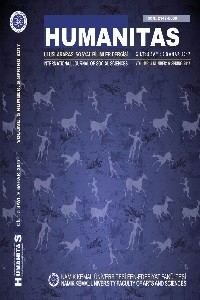Öz
Bu çalışmanın
amacı Türk üniversite öğrencilerin emoji (pictogram) algısını ortaya
çıkarmaktır. Japonca resim anlamına gelen e ile harf anlamına gelen moji
kelimesinin birleşiminden meydana gelen emoji kelimesi; yazılı mesajlarda
duyguları ya da bir takım kavramları ifade etmede kullanılan görsel simge
olarak tanımlanır. Emoji İlk olarak 1998 yılında, Japonya’da bir cep telefonu
firmasında çalışmakta olan Shigetaka Kurita tarafından 176 adet olarak
tasarlanmıştır. 2010 yılında Apple’ın iPhone cihazları üzerinde emojileri
desteklemeye başlamasından sonra emoji kullanımı evrensel bir popülerlik
kazanmıştır. Yazılı mesajlarda emoji kullanımı yaygın bir hâl alırken, bu
konuda ülkemizde yapılan çalışmaların son derece sınırlı olduğunu görmekteyiz.
Bu az sayıdaki çalışmalarda, özellikle genç kuşağın emojiye yönelik olumlu bir
tutuma sahip olduğu vurgulanmaktadır. Bu çalışmada Türk üniversite öğrencilerin
emoji algısı cinsiyet faktörü göz önünde bulundurularak incelenmiştir. Namık
Kemal Üniversitesi’ne mensup 60 erkek ve 60 kadın katılımcıya, “kişisel emoji
ilişkisi” ve “emoji yarar algısı” üzerine sorular sorulmuştur. Analiz yöntemi
olarak, her bir madde için kadın ve erkek öğrencilerin ortalamaları ayrı ayrı
hesaplanarak t testi uygulanmıştır.
Araştırma sonucunda emoji kullanım sıklığının orta seviyede olduğu,
emoji kullanımının olumlu karşılandığı belirlenmiştir. Emoji kullanımının
duyguları ifadede ve mesajları eğlenceli bir hâle getirmede yarar sağladığına
yönelik güçlü bir yargı gözlemlenmektedir. Ayrıca, kadınların erkeklere göre
emoji kullanımının faydalarını daha fazla takdir ettikleri görülmüştür.
Kaynakça
- Barrett, S. (2002): Overcoming transactional distance as a barrier to effective communication over the internet. International Education Journal 3.4, s.34-42. GÖKALİLER, E; SAATCIOĞLU, E.( 2016) Bir Reklam Unsuru Olarak Emoji Kullanımı: Emoji İçerikli Reklamlara Yönelik Tutum Araştırması. Selçuk Üniversitesi Sosyal Bilimler Meslek Yüksek Okulu Dergisi, 19(2) s.63-91. Kitamura H, & Satō S. (2009). Keitai mēru e no emoji fuyo ga joshi daigakusei no inshō keisei ni ataeru kōka. Kanjō shinri-gaku kenkyū, 17 (2 ), s.148 - 156. . Preece,J,Maloney-Krichmar,D;Abras,C (2003),”History of Emergence of Online Communites”İn B.Wellman(Ed.),Encyclopedia of Community. Berkshire Publishing Group,Saga, s.2-3. Rezabek, L.L., & Cochenour,J.J.(1998)Visual cues in computer-mediated communication: Suppleementing text with emoticons. Journal of visual literacy,18,201-215. Rice, R.E., & Love, G. (1987). Electronic emotion socioemotional content in a computer mediated communication network. Communication research, 14(1), 85-108.
Öz
The purpose of this study was to
clarify the emoji (pictogram) attitude
of Turkish university students. E moji, which comes from the combination of e,
meaning japanese picture, and moji words, which means letter; is defined as a
visual symbol used in expressing feelings or some concepts in written messages.
Emoji was originally designed by Shigetaka Kurita, who worked in a mobile phone
company in Japan in 1998,as 176 pieces. In 2010, after Apple began supporting
emoji on iPhone devices, it gained global popularity.While the use of emoji in
written messages is widespread, we understand that the study done in our
country is very limited.In this limited number of studies, It is emphasized
that especially young generation has a positive attitude towards emoji. In this
study, emoji attitude of Turkish university students was examined by
considering the gender factor. Using participants from the Namik Kemal
University,60 males and 60 females were asked about personal emoji releation
and emoji benefit perception. As a method of analysis, averages of male and
female students for each question were calculated separately and t test was applied. As a result of the survey, it
was detirmined that the usage frequency of emoji is medium-level and favorable.
Also, It is observed that ,there is a strong perception that the use of emoji
is beneficial in expressing feelings and makes messages fun. In addition, it
was seen that females appreciate the benefits of using emoji more than males.
Kaynakça
- Barrett, S. (2002): Overcoming transactional distance as a barrier to effective communication over the internet. International Education Journal 3.4, s.34-42. GÖKALİLER, E; SAATCIOĞLU, E.( 2016) Bir Reklam Unsuru Olarak Emoji Kullanımı: Emoji İçerikli Reklamlara Yönelik Tutum Araştırması. Selçuk Üniversitesi Sosyal Bilimler Meslek Yüksek Okulu Dergisi, 19(2) s.63-91. Kitamura H, & Satō S. (2009). Keitai mēru e no emoji fuyo ga joshi daigakusei no inshō keisei ni ataeru kōka. Kanjō shinri-gaku kenkyū, 17 (2 ), s.148 - 156. . Preece,J,Maloney-Krichmar,D;Abras,C (2003),”History of Emergence of Online Communites”İn B.Wellman(Ed.),Encyclopedia of Community. Berkshire Publishing Group,Saga, s.2-3. Rezabek, L.L., & Cochenour,J.J.(1998)Visual cues in computer-mediated communication: Suppleementing text with emoticons. Journal of visual literacy,18,201-215. Rice, R.E., & Love, G. (1987). Electronic emotion socioemotional content in a computer mediated communication network. Communication research, 14(1), 85-108.
Ayrıntılar
| Bölüm | Tüm Sayı |
|---|---|
| Yazarlar | |
| Yayımlanma Tarihi | 3 Ağustos 2017 |
| Yayımlandığı Sayı | Yıl 2017 Cilt: 5 Sayı: 9 |
Cited By
MARKALARIN EMOJİ KULLANIMINA YÖNELİK BİREYLERİN TUTUMLARI: ÜNİVERSİTE ÖĞRENCİLERİ ÜZERİNE BİR ARAŞTIRMA
Süleyman Demirel Üniversitesi Vizyoner Dergisi
https://doi.org/10.21076/vizyoner.556353
Türk Üniversite Öğrencilerinin Duygu Aktarım Amaçlı Emoji Algısı: Namık Kemal Üniversitesi Örneği Üzerine
HUMANITAS - Uluslararası Sosyal Bilimler Dergisi
https://doi.org/10.20304/humanitas.342113
Sosyal Medyada Emoji Kullanımı ve Anlamlandırılması: Anadolu Üniveristesi İletişim Fakültesi Örneği
SELÇUK ÜNİVERSİTESİ İLETİŞİM FAKÜLTESİ AKADEMİK DERGİSİ
Gülten Özdemir
https://doi.org/10.18094/josc.414605









